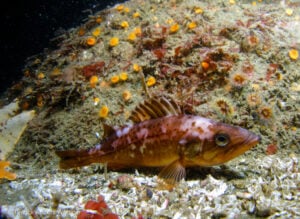British Columbia’s deep waters are home to some of the ocean’s most mysterious and bizarre creatures, including anglerfish. There are many different types of anglerfish, but they all share the defining trait of possessing a bioluminescent lure, with the glow coming from what scientists call “borrowed” bioluminescence. The bioluminescence is borrowed because tiny glowing bacteria called Photobacterium make the lure of anglerfish their home. This is a symbiotic relationship as the Photobacterium gain protection and nutrients in exchange for being anglerfish lure.
In BC waters, notable anglerfish species include the Alaska dreamer, the humpback anglerfish, and the football fish. Each of these species has unique adaptations that make them highly specialized hunters. Their role in the marine food web is crucial, both as predators of smaller deep-sea organisms and as prey for larger species such as sperm whales and sleeper sharks. This role as predator and prey means that they facilitate the movement of energy from lower to higher trophic levels, making them important for the marine food chain.
What Makes an Anglerfish?
Anglerfish are members of the Lophiiformes family, a group of fish distinguished by their bioluminescent lures, large mouths, and deep-sea adaptations. The species found in BC inhabit continental slopes, seamounts, and deep-sea basins, typically at depths of 500 to 2,500 meters, where light does not penetrate. These extreme depths require unique evolutionary adaptations, including low metabolism, energy-efficient hunting strategies, and specialized reproductive methods.
Anglerfish use their glowing lures to attract small deep-sea fish and squid, waiting motionless until prey comes close enough to be snatched up. Their mouths are highly flexible, allowing them to swallow creatures nearly their own size. This is a vital adaptation in the nutrient-scarce deep ocean, where meals can be unpredictable and infrequent.
Species of Anglerfish Found in BC Waters
1. Alaska Dreamer (Oneirodes thompsoni)
The Alaska dreamer is part of the family Oneirodidae and has been documented in BC waters. Notably, Oneirodes thompsoni is among the most commonly encountered deep-sea anglerfish along the BC coast.
In addition to Oneirodes thompsoni, other species within the genus Oneirodes have been recorded in BC waters, including:
- Oneirodes bulbosus
- Oneirodes eschrichtii
- Oneirodes acanthias
Like other members of the Oneirodes genus, the Alaska dreamer has a globular, soft-bodied appearance with dark pigmentation and an oversized head relative to its body.
This species exhibits extreme sexual dimorphism, meaning there are significant differences in size and appearance between males and females. Females can grow up to 21 cm long, while males are dramatically smaller, typically reaching only 1.6 to 3 cm. Unlike females, males lack a lure and do not rely on bioluminescence to hunt. Instead, they consume small fish and invertebrates.
The males have a well-developed sense of smell that allows them to detect females in the vast deep-sea environment, which is important for mating. Unlike some deep-sea anglerfish species, where males attach permanently to females as parasites, Alaskan dreamer males remain free-swimming and do not fuse with a mate.
2. Humpback anglerfish (Melanocetus johnsonii)
The humpback anglerfish is a type of black seadevil and is perhaps the most iconic deep-sea anglerfish, instantly recognizable by its huge, grotesque mouth, long, curved teeth, and jet-black coloration. It was featured on the cover of Time magazine on August 14, 1995, becoming an iconic representation of deep-sea life and one of the most famous anglerfish species. And who could forget its appearance in Finding Nemo? The eerie, alien-like appearance of the humpback anglerfish has captured the imagination of scientists and the public, symbolizing the mysteries of the deep ocean.
The humpback anglerfish is one of the most widely distributed anglerfish species in the world, found in deep waters across the Pacific, Atlantic, and Indian Oceans. In a significant discovery, a specimen was found near Father Charles Canyon off the coast of British Columbia, extending its known range to the north Pacific coast of BC. This finding confirmed that the humpback anglerfish can inhabit colder, more northern waters than previously thought. It lives at depths of 500 to 2,000 meters in continental slopes and deep basins
Like other anglerfish, females of this species possess a bioluminescent lure known as the esca, which they use to attract prey in the pitch-black depths of the ocean. Their dark, scaleless bodies make them nearly invisible in their deep-sea environment, an adaptation that helps them ambush unsuspecting prey. In contrast, males are significantly smaller and lack both the lure and the large teeth.
Scientists have also discovered that individuals of M. johnsonii have an unusually low metabolic rate, even compared to other deep-sea fish. In a laboratory experiment, researchers captured eight M. johnsonii individuals and measured their aerobic metabolism. All of the fish had empty stomachs yet were able to survive by regulating their oxygen consumption, allowing them to tolerate low-oxygen (hypoxic) or even oxygen-free (anaerobic) conditions for extended periods. This ability is a crucial survival strategy in the deep sea, where food is scarce, and oxygen levels can fluctuate.
3. Football Fish (Himantolophus sagamius)
The football fish is one of the largest and most visually striking anglerfish found in BC waters. Named for its round, football-shaped body, this species belongs to the Himantolophidae family and is found in zones often deeper than 1,500 meters.
Football fish also employ parasitic mating, where males permanently attach to females. Males attach themselves to females and gradually lose their eyes, internal organs, and all other body parts except for their testes. They become a permanent extension of the female, drawing nutrients from her while remaining a ready source of sperm for reproduction. However, this species is particularly rare, with most specimens discovered through accidental deep-sea trawling or strandings. In the case of football fish in BC, there is no evidence of permanent parasitic mating. However, it may be the case that some engage in temporary attachment during mating.
Are BC’s Anglerfish Under Threat?
Currently, anglerfish species in BC are not directly endangered, but they face several environmental risks:
- Deep-Sea Trawling: While anglerfish are not a target species, bottom trawling damages their fragile habitat.
- Global Warming: Rising ocean temperatures and changes in prey distribution could alter their feeding success.
- Microplastic Contamination: Deep-sea fish are increasingly ingesting microplastics, which could have unknown long-term effects.
Recently, a humpback anglerfish was filmed hundreds of metres above its usual habitat in the shallow part of the ocean off the coast of Tenerife. This unusual sighting prompted concerns from scientists, who speculated that factors such as global warming could be altering deep-sea habitats, potentially forcing these creatures out of their natural depths. Other possible explanations include disorientation due to illness, environmental stress, or a powerful upwelling current carrying the fish to the surface.
Conclusion
The anglerfish of British Columbia are some of the most bizarre and well-adapted predators of the deep sea. Each species has evolved unique characteristics, from the needle-toothed Alaska dreamer to the ghostly humpback anglerfish and the formidable football fish. Though not directly threatened, their habitat is changing due to human activity, making further research and conservation efforts crucial. These ambush predators play a vital role in regulating deep-sea food webs, ensuring the balance of marine life in the abyssal depths.




